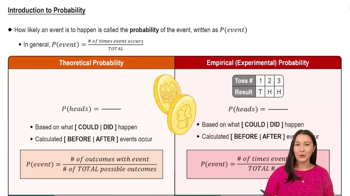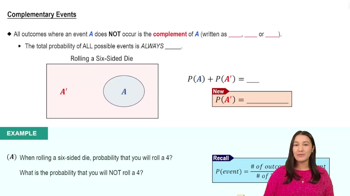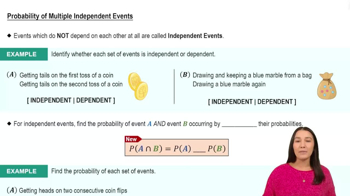Happiness In a survey sponsored by Coca-Cola, subjects were asked what contributes most to their happiness, and the table summarizes their responses. Does the table represent a probability distribution? Explain.
Table of contents
- 1. Intro to Stats and Collecting Data1h 14m
- 2. Describing Data with Tables and Graphs1h 55m
- 3. Describing Data Numerically2h 5m
- 4. Probability2h 16m
- 5. Binomial Distribution & Discrete Random Variables3h 6m
- 6. Normal Distribution and Continuous Random Variables2h 11m
- 7. Sampling Distributions & Confidence Intervals: Mean3h 23m
- Sampling Distribution of the Sample Mean and Central Limit Theorem19m
- Distribution of Sample Mean - Excel23m
- Introduction to Confidence Intervals15m
- Confidence Intervals for Population Mean1h 18m
- Determining the Minimum Sample Size Required12m
- Finding Probabilities and T Critical Values - Excel28m
- Confidence Intervals for Population Means - Excel25m
- 8. Sampling Distributions & Confidence Intervals: Proportion1h 12m
- 9. Hypothesis Testing for One Sample3h 29m
- 10. Hypothesis Testing for Two Samples4h 50m
- Two Proportions1h 13m
- Two Proportions Hypothesis Test - Excel28m
- Two Means - Unknown, Unequal Variance1h 3m
- Two Means - Unknown Variances Hypothesis Test - Excel12m
- Two Means - Unknown, Equal Variance15m
- Two Means - Unknown, Equal Variances Hypothesis Test - Excel9m
- Two Means - Known Variance12m
- Two Means - Sigma Known Hypothesis Test - Excel21m
- Two Means - Matched Pairs (Dependent Samples)42m
- Matched Pairs Hypothesis Test - Excel12m
- 11. Correlation1h 6m
- 12. Regression1h 50m
- 13. Chi-Square Tests & Goodness of Fit1h 57m
- 14. ANOVA1h 57m
5. Binomial Distribution & Discrete Random Variables
Binomial Distribution
Problem 5.CRE.2c
Textbook Question
Kentucky Pick 4 In the Kentucky Pick 4 lottery game, you can pay $1 for a “straight” bet in which you select four digits with repetition allowed. If you buy only one ticket and win, your prize is $2500.
c. If you play this game once every day, find the probability of no wins in 365 days.
 Verified step by step guidance
Verified step by step guidance1
Step 1: Understand the problem. In the Kentucky Pick 4 lottery game, you select four digits with repetition allowed. The total number of possible outcomes is 10^4 (since there are 10 digits, 0 through 9, and repetition is allowed). The probability of winning on a single ticket is 1 divided by the total number of outcomes.
Step 2: Calculate the probability of losing on a single ticket. The probability of losing is the complement of the probability of winning, which is given by P(losing) = 1 - P(winning).
Step 3: Recognize that the problem involves repeated independent trials. If you play the game once every day for 365 days, the probability of no wins in 365 days is the probability of losing every single day. Since the trials are independent, the probability of losing every day is the product of the probability of losing on each day.
Step 4: Use the formula for the probability of no wins in 365 days: P(no wins) = P(losing)^365. Substitute the value of P(losing) from Step 2 into this formula.
Step 5: Simplify the expression for P(no wins) to get the final probability. You can leave the result in terms of powers or logarithms for further calculation if needed.
 Verified video answer for a similar problem:
Verified video answer for a similar problem:This video solution was recommended by our tutors as helpful for the problem above
Video duration:
3mPlay a video:
Was this helpful?
Key Concepts
Here are the essential concepts you must grasp in order to answer the question correctly.
Probability of Winning
In the Kentucky Pick 4 lottery, the probability of winning a straight bet is calculated by determining the total number of possible combinations of four digits (0000 to 9999), which is 10,000. Therefore, the probability of winning with one ticket is 1 in 10,000, or 0.0001.
Recommended video:

Introduction to Probability
Complementary Probability
Complementary probability refers to the likelihood of an event not occurring. In this case, the probability of not winning with one ticket is 1 minus the probability of winning. Thus, the probability of no wins in a single day is 1 - 0.0001 = 0.9999.
Recommended video:

Complementary Events
Independent Events
In probability theory, independent events are those whose outcomes do not affect each other. Playing the lottery each day is an independent event, meaning the outcome of one day does not influence the next. To find the probability of no wins over 365 days, we raise the daily no-win probability to the power of 365: (0.9999)^365.
Recommended video:

Probability of Multiple Independent Events

 6:00m
6:00mWatch next
Master The Binomial Experiment with a bite sized video explanation from Patrick
Start learningRelated Videos
Related Practice
Textbook Question
